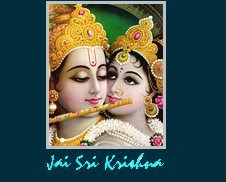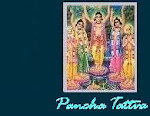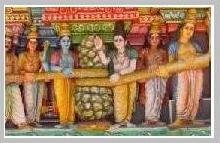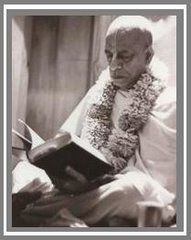on this earth in the family lineage
descending from Uddharan Dhatta
"Uddharana Datta Thakura, the eleventh among the twelve cowherd boys, was an exalted devotee of Lord Nityananda Prabhu. He worshiped the lotus feet of Lord Nityananda in all respects"
PURPORT
"Srila Bhaktisiddhanta Sarasvati Thakura writes in his Anubhasya, 'The Gaura-ganoddesa-dipika (129) states that Uddharana Datta Thakura was formerly the cowherd boy of Vrndavana named Subahu. Uddharana Datta Thakura, previously known as Sri Uddharana Datta, was a resident of Saptagrama, which is situated on the bank of the Sarasvati River near the Trisabigha railway station in the district of Hugli. At the time of Uddharana Thakura, Saptagrama was a very big town,encompassing many other places such as Vasudeva-pura, Bansabediya, Krsnapura, Nityananda-pura, Sivapura, Sankhanagara and Saptagrama.'
It is also said in the Gaura ganoddessa-dipika (14) "The associates of Lord Nityananda were all cowherd boys during Lord Krsna's advent"
"Calcutta was developed under British rule by the influential mercantile community, and especially by the suvarna-vanik community who came down from Saptagrama to establish their businesses and homes all over Calcutta. They were known as the Saptagrami mercantile community of Calcutta, and most of them belonged to the Mullik and Sil families. More than half of Calcutta belonged to this community, as did Srila Uddharana Thakura. Our paternal family also came from this district and belonged to the same community. The Mulliks of Calcutta are divided into two families, namely the Sil family and De family. All the Mulliks of the De family originally belong to the same family and gotra. We also formerly belonged to the branch of the De family whose members, intimately connected with the Muslim rulers, received the title Mullik.
"In the Caitanya-bhagavata, Antya-khanda, Chapter Five, it is said that Uddharana Datta was an extremely elevated and liberal Vaisnava. He was born with the right to worship Nityananda Prabhu. It is also stated that Nityananda Prabhu, after staying for some time in Khadadaha, came to Saptagrama and stayed in the house of Uddharana Datta. The suvarna-vanik community to which Uddharana Datta belonged was actually a Vaisnava community. Its members were bankers and gold merchants (suvarna means 'gold,' and vanik means 'merchant'). Long ago there was a misunderstanding between Ballal Sena and the suvarna-vanik community because of the great banker Gauri Sena. Ballal Sena was taking loans from Gauri Sena and spending money extravagantly, and therefore Gauri Sena stopped supplying money. Ballal Sena took revenge by instigating a social conspiracy to make the suvarna-vaniks outcastes, and since then they have been ostracized from the higher castes, namely the brahmanas, ksatriyas and vaisyas. But by the grace of Srila Nityananda Prabhu, the suvarna-vanik community was again elevated. It is said in the Caitanya-bhagavata, yateka vanik-kula uddharana haite pavitra ha-ila dvidha nahika ihate: there is no doubt that all the community members of the suvarna-vanik society were again purified by Sri Nityananda Prabhu.
"In Saptagrama there is still a temple with a six-armed Deity of Sri Caitanya Mahaprabhu that was personally worshiped by Srila Uddharana Datta Thakura. On the right side of Sri Caitanya Mahaprabhu is a Deity of Sri Nityananda Prabhu, and on the left side is Gadadhara Prabhu. There are also a Radha-Govinda murti and a salagrama-sila, and below the throne is a picture of Sri Uddharana Datta Thakura. In front of the temple there is now a big hall, and in front of the hall is a Madhavi-lata plant. The temple is in a very shady, cool and nicely situated location. When we returned from America in 1967, the executive committee members of this temple invited us to visit it, and thus we had the opportunity to visit this temple with some American students. Formerly, in our childhood, we visited this temple with our parents because all the members of the suvarna-vanik community enthusiastically take interest in this temple of Uddharana Datta Thakura.
"Srila Bhaktisiddhanta Sarasvati Thakura adds in his Anubhasya: 'In the Bengali year 1283 [A.D. 1876] a babaji of the name Nitai dasa arranged for a donation of twelve bighas of land (about four acres) for the temple where Uddharana Datta Thakura worshiped. The management of the temple later deteriorated, but then in 1306 (A.D. 1899), through the cooperation of the famous Balarama Mullik of Hugli, who was a subjudge, and many rich suvarna-vanik community members, the management of the temple improved greatly. Not more than fifty years ago, one of the family members of Uddharana Datta Thakura named Jagamohana Datta established a wooden murti [statue] of Uddharana Datta Thakura in the temple, but that murti is no longer there; at present, a picture of Uddharana Datta Thakura is worshiped. It is understood, however, that the wooden murti of Uddharana Thakura was taken away by Sri Madana-mohana Datta and is now being worshiped with a salagrama-sila by Srinatha Datta.
" 'Uddharana Datta Thakura was the manager of the estate of a big zamindar in Naihati, about one and a half miles north of Katwa. The relics of this royal family are still visible near the Dainhata station. Since Uddharana Datta Thakura was the manager of the estate, it was also known as Uddharana-pura. Uddharana Datta Thakura installed Nitai-Gaura Deities that were later brought to the house of the zamindar, which was known as Vanaoyaribada. Srila Uddharana Datta Thakura remained a householder throughout his life. His father's name was Srikara Datta, his mother's name was Bhadravati, and his son's name was Srinivasa Datta.' " [Adi 11.41]
There is also an interesting tree that is said to have grown from a cooking spoon that Nityananda Prabhu planted in the ground.



















